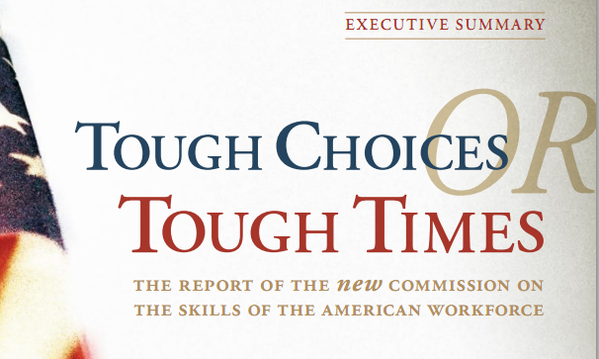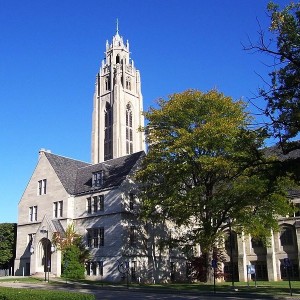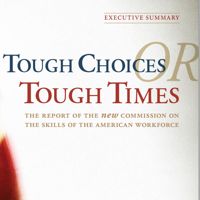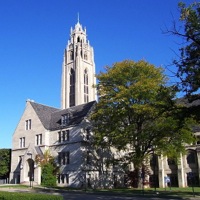21st Century Skills or Adequate Yearly Progress?
The Boston Globe (October 30, 2008) recently reported on efforts to redirect district curriculum to "skills the district has deemed necessary for survival in the 21st century, including critical thinking, invention, problem-solving, and multicultural collaboration."
"Accountability is a good thing. Learning standards are a good thing. But is focusing on one test a fair measure of student success? I think that answer is, 'No,' " said Laura Salomons, a School Committee member since May and a mother of four.
Salomons has submitted a proposal that seeks community support for allowing teachers to avoid tailoring their lessons to the MCAS. Instead, she would like to see teachers directed to instruct students on skills the district has deemed necessary for survival in the 21st century, including critical thinking, invention, problem-solving, and multicultural collaboration.
"I have come to the conclusion that we, as a school district, may be overly consumed with doing well on MCAS," Salomons began in her eight-page proposal. "The focus is a detriment to reaching the school committee and superintendent's goal of 'providing students with . . . learning opportunities that encourage lifelong learning skills and that support a student's artistic, social, emotional and physical development.' " More
I find that I rarely get asked to do staff development to "bring the scores up." Increasingly I'm asked to help teachers create more engaging learning environments for students.
While NCLB began with the admirable goal of narrowing demographic performance gaps and putting an end to sorting kids on the “bell curve,” it may be doing just the opposite. Many of our schools are now compelled to force feed the content required for “adequate progress” as measured by standardized state tests. Does test prep = academic "feed-lot?"
Too little time is left for student-centered, project-based learning that allows students to work at the upper level of Bloom. Innovation requires much trial and error (Bloom’s evaluation). Learning to self-assess your problem solving approach is not a skill fostered in multiple-choice test-prep environment.
NCLB correctly put the focus on student achievement. Our students will need a strong foundation in core concepts. But schools can’t be filled with routine tasks. They need to be fluid environments focused on helping students take responsibility for thinking and problem solving where there sometimes isn’t a right answer.
Reinventing Your Classroom
I taught high school for over 25 years and liked that each fall I had the chance to “reinvent” my classroom. That’s a perspective I’ll be sharing with teachers in the “opening day” workshops I’ll be giving over the few weeks. My travels will take me from Pennsylvania to Wyoming and on to Oregon. I’ll face countless teachers thinking about new students and new opportunities for teaching and learning.
A recent blog post in Techlearning Blog captured that back to school reflection. Jeff Utecht makes the point that our students are used to “free information” and asks some thought provoking questions. He writes:
Our students believe that things should be free. They have grown up with an Internet where any information you want you can get for free. … How do we engage students who are used to information being free? …How do we get them to dig deeper and understand this free information?….We have to create an atmosphere of learning, a place that students want to come and want to learn. What do you give that is free that engages students? What is it that they come to your classroom for that they cannot get off the Internet in a faster, more visually stimulating way? … So what are you going to do in your classroom this year that engages THESE students?… What is it that you can offer them that they cannot get anywhere else? How are you going to get them to dig deeper, to interact with knowledge rather than react from it? How are you going to engage students in the learning process and not allow them to be passive in their own learning?…This is our challenge! More
I agree with Jeff – students do expect free information. And they expect functionality – to be able to control information and customize it into something they can call their own. Their life has become an “open book test” and they get the information they want, when they want to – then they store it, catalogue it, alter it, and share it. There are few information gatekeepers in today’s world – students have become their own newscaster, librarian, and entertainment director.
This is an exciting time to be in education. There are so many interesting tools for creating learning environments. Over the next week I look forward to meeting many teachers who create classrooms where students can take on the challenge of intellectual work – rather than just look for the right answer. Teachers who want school to be more rigorous, relevant and engaging. Classrooms that give students opportunities to learn how professionals approach their work – scientist, engineer, artist, historian, mathematician, writer, and musician.
Teaching Innovation in Routine Schools?

Tough Choices or Tough Times
On December 14, 2006, the New Commission on the Skills of the American Workforce, unveiled a report which should keep educators and policy-makers talking for months to come. Tough Choices or Tough Times, offers both a sober assessment of the challenge (Tough Times) and a radical proposal for reform of our educational system (Tough Choices). Executive Report 1.9MB pdf
Already the report is drawing both praise and heavy criticism. See: “U.S. Urged to Reinvent Its Schools” Education Week December 20, 2006. More 35kb pdf
The report assesses the demands of the information age / global economy against the current trends in American education. In our efforts to shore up the basic competencies of our students we have sacrificed creativity. Our schools have been taken over by the “test-prep” mentality. Typically that involves putting our student through relentless repetition of formulaic approaches to finding “the right answer.” More
As Washington considers the reauthorization of NCLB, I hope someone asks the question, “Why are we training our students to perform routine tasks, when routine work is increasingly done by machines and low-wage labor?”
As Tough Choices or Tough Times states, “A swiftly rising number of American workers at every skill level are in direct competition with workers in every corner of the globe. …If someone can figure out the algorithm for a routine job, chances are that it is economic to automate it. Many good well-paying, middle-class jobs involve routine work of this kind and are rapidly being automated.
…The best employers the world over will be looking for the most competent, most creative, and most innovative people on the face of the earth and will be willing to pay them top dollar for their services. This will be true not just for the top professionals and managers, but up and down the length and breadth of the workforce.
…Strong skills in English, mathematic: technology and science, as well as literature, history, and the arts will be essential for many; beyond this, candidates will have to be comfortable with ideas and abstractions, good at both analysis and synthesis, creative and innovative, self-disciplined and well organized, able to learn very quickly and work well as a member of a team and have the flexibility to adapt quickly to frequent changes in the labor market as the shifts in the economy become ever faster and more dramatic.”
To prepare our students to lead productive and fulfilling lives, they will need both core competencies and opportunities to explore creative solutions that are “outside the box.” Let’s not forget “synthesis” – one of Bloom’s higher-order thinking skills. It’s been defined as: “Creatively or divergently applying prior knowledge and skills to produce a new or original whole.”
We can’t blame teachers for abandoning project-based learning when they get the message that we have to get “the scores up.” It’s time to refine our thinking about educational accountability. We will need to produce a new generation of students with both solid skills and the ability to apply them in new and creative ways.
As the report concludes, “Creativity, innovation, and flexibility will not be the special province of an elite. It will be demanded of virtually everyone who is making a decent living, from graphic artists to assembly line workers, from insurance brokers to home builders.”
See new post “Teaching innovation in routine schools? Part II”
The Arts of the World Within Reach: Creating the Cornerstone for Access

Washington DC: Peter Pappas will serve as an advisor to the Memorial Art Gallery, University of Rochester – Rochester, NY. The museum is a recipient of a 2006 Institute of Museum and Library Services grant – Museums for America – Sustaining Cultural Heritage.
The project includes management and educational activities targeting the gallery’s collections of ancient, Asian, European, Meso- and Native American, and African Art. Activities include full research and documentation for 250 landmark works of art; the addition of 1,525 images to the collections database and website; and the purchase and use of technology for increased storage capacity, backup capability, and security of digital image files. A new curriculum-based educational module will be developed based on core works in the targeted collections. New technology will provide shared access to educational materials and images. The project will support the development of innovative installations of the permanent collection and public access to the entire collection through technological initiatives.
Image credit: Memorial Art Gallery Cutler Union east side



